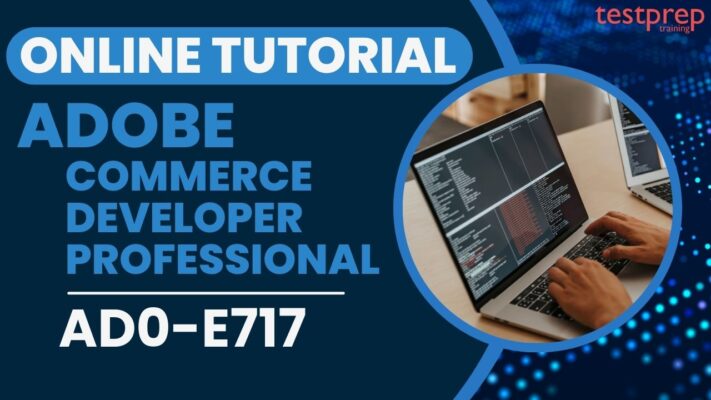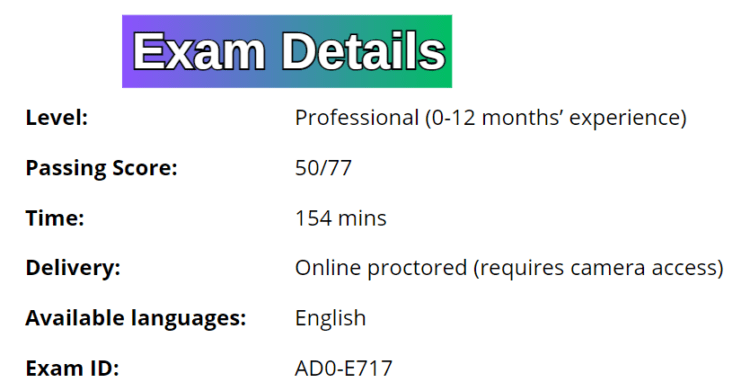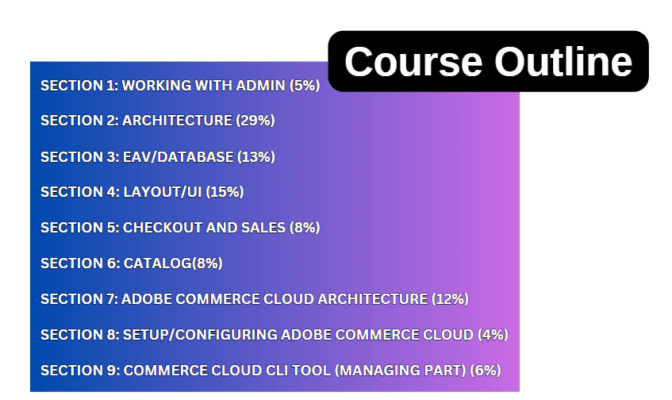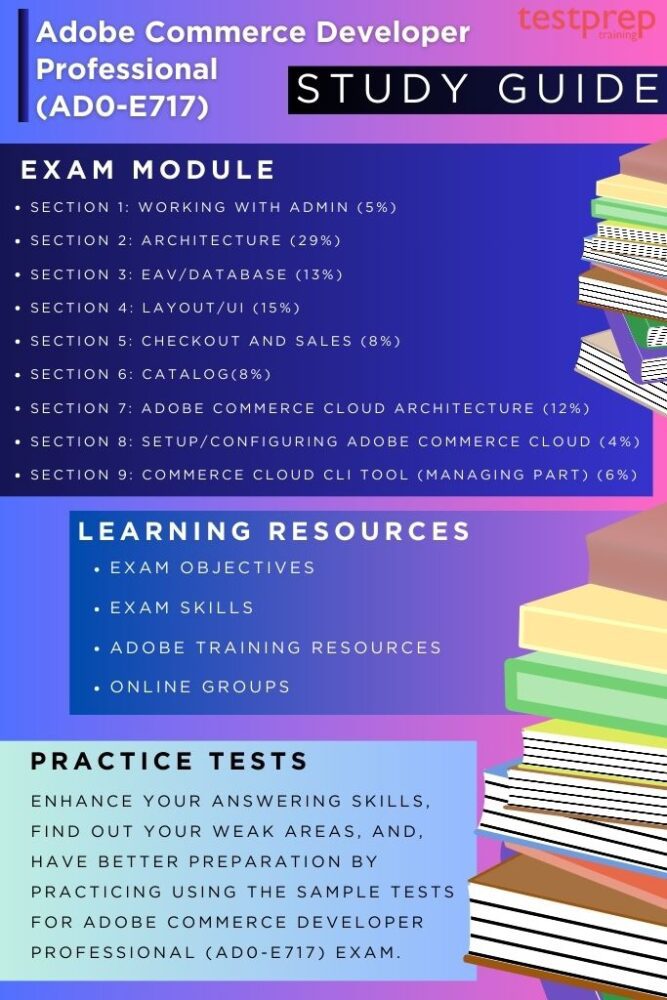Adobe Commerce Developer Professional (AD0-E717)

The Adobe Commerce Developer Professional (AD0-E717) exam is a gateway for developers looking to validate their skills in building and customizing Adobe Commerce (formerly Magento) storefronts. The exam assesses candidates’ competency in core areas like building custom extensions, leveraging the platform’s architecture, and implementing theme customizations. By clearing the AD0-E717 exam, you demonstrate a foundational understanding of Adobe Commerce development, making candidates a valuable asset for e-commerce teams working on building and maintaining online stores.
Target Audience:
The Adobe Commerce Developer Professional (AD0-E717) exam is for:
- Developers
- Lead Developers
- Backend Developer
- Solution Architects
- Technical Leaders
Knowledge Requirement:
Candidates should feel confident working within Adobe Commerce and possess a foundational understanding of Adobe Commerce administrative development, architecture, EAV/database management, layout and user interface (UI) design, checkout and sales processes, and catalog management.
Exam Details

The Adobe Commerce Developer Professional (AD0-E717) exam is classified at the Professional level, suitable for candidates with 0-12 months of experience. It requires a passing score of 50 out of 77, has a time limit of 154 minutes, and is conducted online with proctoring that necessitates camera access. This exam is available in English.
Course Outline
The exam covers various exam objectives that include:

Section 1: Working with Admin (5%)
- Describe how the ACL works with roles and resources
- Identify the components to use when creating or modifying the admin grid/form
- Identify the files to use when creating a store/admin config and menu items
Section 2: Architecture (29%)
- Describe Magento file structure
- Describe Magento CLI commands
- Describe cron functionality
- Given a scenario, describe usage of the di.xml
- Given a scenario, create controllers
- Describe module structure
- Describe index functionality
- Describe localization
- Describe plugin, preference, event observers, and interceptors
- Describe custom module routes
- Describe URL rewrites
- Describe the Magento caching system
- Describe stores, websites, and store views (basic understanding)
Section 3: EAV/database (13%)
- Given a scenario, change/add/remove attribute sets and/or attributes
- Describe different types of attributes
- Given a scenario, use a DB schema to alter a database table
- Describe models, resource models, and collections
- Describe basics of Entity Attribute Value (EAV)
Section 4: Layout/UI (15%)
- Apply changes to existing product types and create new ones
- Modify and extend existing Catalog entities
- Demonstrate the ability to manage Indexes and customize price output
- Explain how multi-source inventory impacts stock (program level)
Section 5: Checkout and sales (8%)
- Describe cart components
- Describe a cart promo rule
- Given a scenario, describe basic checkout modifications
- Given a scenario, describe basic usage of quote data
- Given a scenario, configure the payment and shipping methods
- Given a scenario, configure tax rules, currencies, cart, and/or checkout
Section 6: Catalog(8%)
- Identify the basics of category management and products management
- Describe product types
- Describe price rules
- Describe price types
Section 7: Adobe Commerce Cloud architecture (12%)
- Define Adobe Commerce architecture/environment workflow
- Describe cloud project files, permission, and structure
- List services available on Adobe Commerce on Cloud
- Describe how to access different types of logs
- Describe steps for applying patches (Identify which folder to put patches in)
- Describe how to Maintain and upgrade ECE tools
- Identify when to call support *Yaml files and limitations (DIY vs Support tickets)
Section 8: Setup/Configuring Adobe Commerce Cloud (4%)
- Identify how to setup/configure Adobe Commerce Cloud
- Define Basic Cloud troubleshooting (Hierarchy of web UI and variables, configurations precedence)
- Recognize basic knowledge of cloud user management and onboarding UI
- Describe environment Management using UI
- Describe branching using UI
- Identify Adobe Commerce Cloud Plan capabilities
Section 9: Commerce Cloud CLI tool (Managing part) (6%)
- Describe exclusive features of Adobe Commerce Cloud CLI tool (CLI exclusive features: activate emails, rebase environments, snapshot, db dump, local environment setup)
- Describe branching using the Adobe Commerce Cloud CLI tool
- Identify ways to connect to cloud services? (My SQL, Redis, tunnel:info)
FAQs: Adobe Commerce Developer Professional (AD0-E717) Exam
Exam Policies
The Adobe exam covers various exam policies that can help candidates understand the exam pattern more accurately.
Renewing your certification:
Certifications have a validity period of two years. To keep your certification current, you need to renew it before it expires. Adobe certifications also require renewal every two years. Failure to renew before expiration will necessitate retaking the complete certification exam for recertification.
Study Guide for Adobe AD0-E717 Exam

1. Understand the Exam Objectives
Passing the Adobe Commerce Developer Professional (AD0-E717) exam depends on a thorough understanding of its objectives. These objectives serve as a blueprint, outlining the specific skills and knowledge Adobe expects candidates to have in developing on the Adobe Commerce platform. By meticulously exploring these objectives, candidates can plan their exam preparation for maximum impact. The objectives highlight the core areas of development that will be assessed. This allows candidates to concentrate their efforts on the most crucial topics, maximizing their learning efficiency.
2. Understand the Exam Technologies and Environment
Candidates should have familiarity with the following technologies and environments:
- Adobe Commerce (version 2.4)
- Solid understanding of PHP
- Proficiency in MySQL
- Understanding of Object-Oriented Programming (OOP)
- Knowledge of Cloud Architecture
3. Use the Official Adobe Resources
For comprehensive details about the exam, visit Adobe’s official website. The Adobe Experience League platform offers in-depth information on the exam, covering its objectives, and scope, and providing extensive resources such as:
– Adobe Commerce Foundations Course:
This course offers fundamental training that covers essential product fundamentals, program functionalities, critical use cases, and real-world examples. Whether you are new to e-commerce or an experienced user, this course equips you with the knowledge and insights necessary to navigate the dynamic landscape of Adobe Commerce.
– Adobe Commerce for Developers Professional Course:
Enroll in the Adobe Commerce Developer Professional Course, which explains essential concepts, practical demonstrations, and knowledge assessments. For beginners, the Adobe Commerce Foundations Course provides a foundational understanding to support your certification journey. Enhance your Adobe Commerce development skills with our comprehensive Adobe Commerce Developer Course, now updated with the latest advancements in extensibility, microservices, and developer experience. This course helps developers at all levels, aiming to deepen their expertise and remain competitive in the continually evolving e-commerce industry.
– Free Prep Guide:
The free Exam Prep Guide offers a personalized roadmap to navigate your exam preparation journey, detailing the essential materials necessary for exam success. Within this guide, you will gain insights into the exam’s structure and the key concepts it covers. It serves as a valuable resource to aid your certification preparation by providing resources aligned with the exam’s objectives.
– Readiness Questionnaire:
Adobe categorizes a Commerce Developer Professional as an intermediate-level position that necessitates a minimum of 2 years of practical experience with Magento Open Source or Adobe Commerce, along with robust technical proficiency. The Readiness Questionnaire for the Adobe Commerce Developer Professional exam (AD-Q-E717) evaluates the essential knowledge and experience required for candidates preparing to sit for the exam. This online self-assessment tool allows candidates to assess if their current expertise aligns with the recommended minimum qualifications for the exam.
4. Join Forums, Groups, and Read Blogs
Discover dedicated blog posts and articles aimed at preparing for the AD0-E717 exam, offering valuable tips and insights from experienced professionals. Engage actively in online communities and forums focused on Adobe Analytics to connect with peers and industry experts. Participating in these platforms allows you to join discussions, share experiences, and receive valuable advice that enhances your exam readiness and professional development. These interactions are instrumental in advancing your understanding and readiness as you progress through your certification journey.
5. Take Practice Tests
Regularly practicing with AD0-E717 exam tests is essential to pinpoint your strengths and areas requiring improvement. This practice refines your ability to handle exam questions effectively and improves your time management skills for the actual test. To maximize readiness, schedule these simulations after thoroughly studying each exam topic. This approach strengthens your grasp of the material and ensures thorough preparation for the exam.



